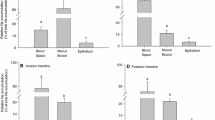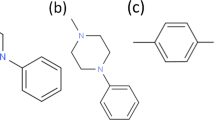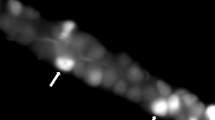Summary
In anaesthetized guinea pigs N-(3H)methylscopolamine (NMScop), N1-(14C)methylnicotinamide (NMN), and (14C)tetraethylammonium (TEA), administered intravenously, were secreted against a concentration gradient into the lumen of the small intestine. The concentration ratio of unmetabolized ammonium base in the intestinal lumen to that in the plasma was 4.3 and 6.5 for NMScop and NMN, respectively, 75 min after the intravenous injection of 1 nmole/g body weight of the individual compounds. The corresponding value for TEA after 180 min was 2.0. The establishment of the concentration gradient between intestinal lumen and plasma was diminished with increasing doses. An excess of NMN inhibited the uphill transport of NMScop. Since the electrical potential difference across the intestinal epithelium and a ‘fluid circuit’ mechanism cannot solely account for the observed accumulation of the monoquaternary ammonium compounds in the intestinal lumen, the evidence presented supports previous in vitro findings that the small intestine is capable of actively secreting organic cations.
Similar content being viewed by others
References
Asano, T.: Effects of sugars on potential differences across wall of small intestine of rodents. Proc. Soc. Exp. Biol. 119, 189–192 (1965)
Bray, G. A.: A simple efficient liquid scintillator for counting aqueous solutions in a liquid scintillation counter. Anal. Biochem. 1, 279–285 (1960)
Hendrix, T. R., Bayless, T. M.: Digestion: Intestinal secretion. Ann. Rev. Physiol. 32, 139–164 (1970)
Ingraham, R. C., Peters, H. C., Visscher, M. B.: On the movement of materials across living membranes against concentration gradients. J. Physical Chem. 42, 141–151 (1938)
Kolassa, N., Krivanek, P., Turnheim, K.: A secretory process for trimethoxybenzoic acid in the guinea pig jejunum. Naunyn-Schmiedeberg's Arch. Pharmacol. 293, R45 (1970)
Lauterbach, F.: Werden quaternäre Ammoniumverbindungen über einen enteralen Sekretionsmechanismus resorbiert? Naunyn-Schmiedeberg's Arch. Pharmak. 266, 388–389 (1970)
Lauterbach, F.: Untersuchungen über den Mechanismus der Permeation cardiotoner Steroide durch die Mucosa des Dünndarmes-ein Beitrag zur Theorie der Resorption von Pharmaka. Habilitationsschrift, Bochum/Essen 1971a
Lauterbach, F.: Absorption of cardiac glycosides. Acta Pharmacol. Toxicol. (Kbh.) 29, Suppl. 4, 80 (1971b)
Lauterbach, F.: Resorption und Sekretion von Arzneistoffen durch die Mucosaepithelien des Gastrointestinaltraktes. Arzneim.-Forsch. (Drug Res.) 25, 479–488 (1975)
Lauterbach, F.: Intestinal secretion of organic ions and drugs. In: Intestinal Permeation (Kramer, M. and Lauterbach, F., eds.), pp. 173–194. Amsterdam-Oxford: Excerpta Medica 1977
Powell, D. W., Malawer, S. J., Plotkin, G. R.: Secretion of electrolytes and water by the guinea pig small intestine in vivo. Am. J. Physiol. 215, 1226–1253 (1968)
Quinn, G. P., Greengard, P.: The pathway for the biosynthesis of N1-methyl-4-pyridone-3-carboxamide. Arch. Biochem. Biophys. 115, 146–152 (1966)
Rose, R. C., Schultz, S. G.: Studies on the electrical potential profile across rabbit ileum. J. Gen. Physiol. 57, 639–663 (1971)
Schultz, S. G., Frizzell, R. A. Nellans, H. N.: Ion transport by mammalian small intestine. Ann. Rev. Physiol. 36, 51–91 (1974)
Smith, R. I.: Excretion of drugs in bile. In: Handbook of Experimental Pharmacology Vol. 28/1 (Brodie, B. B., Gillette, J. R., eds.), pp. 354–389. Berlin-Heidelberg-New York: Springer 1971
Stranulovic, M., Chaykin, S.: Aldehyde oxydase: catalysis of oxydation of N1-methylnicotinamide and pyridoxal. Arch. Biochem. Biophys. 145, 27–34 (1971a)
Stranulovic, M., Chaykin, S.: Metabolic origins of the pyridones of N1-methylnicotinamide in man and rat. Arch. Biochem. Biophys. 145, 35–42 (1971b)
Turnheim, K., Lauterbach, F.: Absorption and secretion of monoquaternary ammonium compounds by the isolated intestinal mucosa. Biochem. Pharmacol. 26, 99–108 (1977)
Vogel, G., Passmann, H., Meyering, E.: Besonderheiten der Sorption im Intestinaltrakt des Meerschweinchens. Bicarbonat-“Sekretion” und Flüssigkeitsenterosorption längs des gesamten Dünndarmes. Pflügers Arch. 321, 259–273 (1970)
Weiner, I. M.: Excretion of drugs by the kidney. In: Handbook of Experimental Pharmacology, Vol 28/1 (Brodie, B. B., Gillette, J. R., eds.), pp. 328–353. Berlin-Heidelberg-New York: Springer 1971
Author information
Authors and Affiliations
Rights and permissions
About this article
Cite this article
Turnheim, K., Lauterbach, F. Secretion of monoquaternary ammonium compounds by guinea pig small intestine in vivo. Naunyn-Schmiedeberg's Arch. Pharmacol. 299, 201–205 (1977). https://doi.org/10.1007/BF00500311
Received:
Accepted:
Issue Date:
DOI: https://doi.org/10.1007/BF00500311




